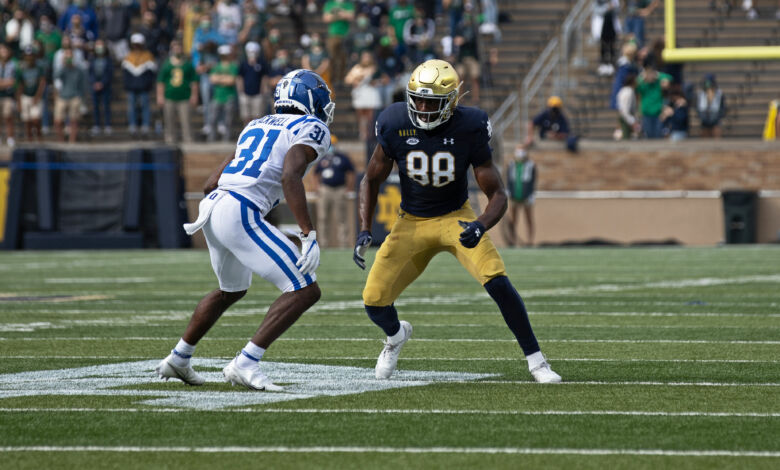
The entire offense was a struggle for Notre Dame to open the game against Duke last Saturday. The running game was stagnant and the passing game was non existent. Consequently, the team finished their first three possessions without a achieving a first down. Not great!
But, while the running game picked up and showed promising signs as the game went on, the passing game remained disjointed and awkward. Quarterback Ian Book wasn’t comfortable in the pocket, and when he did settle in there was little in the way of an open receiver. It mostly a big mess.
Some of this can be attributed to personnel. Everyone knows Kevin Austin isn’t playing, but neither did Braden Lenzy due to a hamstring issue, and they are arguably the team’s top two receivers. So that’s not ideal.
But, Notre Dame, with their 5th-year senior quarterback and an offensive line that excels at protecting the passer, ought to be able to throw together something a little bit more efficient than that. Watching the game back, some things jumped out where the team can improve, at quarterback, play calling, and pass catcher.
More Play Action And Screen Game
Over the course of the game, Notre Dame dropped back to pass 29 times. From those dropbacks, the offense gained 117 yards, they were sacked three times, threw one pick (and had another interception called back), and had one touchdown pass. Those 29 dropbacks averaged 4.03 yards per play. Not very efficient to say the least.
By contrast, Notre Dame ran eight play action or screen passes, those resulted in 140 yards through the air and one Book scramble. For those scoring at home that 17.5 yards per play. If you want to remove the 75-yard screen to Williams, then it’s 9.3 yards per play on seven attempts, still far more efficient than their straight drop passing game.
One thing you’ll notice when watching these plays is there is a ton of motion and movement, either from receivers or Ian Book. This is where Ian Book thrives – when he’s in rhythm and moving around the pocket. We’ve seen Ian Book for three seasons now, dropping him back 29 times in a game, especially with this receiving corps, is not taking advantage of his skill set. He likes to move around, so move him around.
And it looks like Notre Dame is going to have a pretty stout running game, at the very least one that has to be respected. Most of their passing concepts should then come off of play-action. Give the defense something to hesitate over! When you are dropping back, the defense doesn’t have to think, they don’t have to read anything. Play action causes hesitation, which slows down the defense, which then gives the receivers advantages that they need.
It’s not that Notre Dame should never have a straight drop, of course they should, but a 29 to eight ratio on dropbacks vs play action and the screen game isn’t conducive to a dangerous passing game, and it doesn’t take advantage of the strengths of your quarterback.
Find The Best Three And Play Them
This sounds like Captain Obvious, but I’m not sure this is what Notre Dame is currently doing so it’s got to be stated. Play your best guys, regardless of position. Notre Dame too often locks a player into the X, or the W, or the Z. So Joe Wilkins can’t play in the slot or the W because he’s a boundary guy. I don’t know, he seemed like one the best guys on Saturday, and he only got out there because Ben Skowronek hurt his hamstring. Find your best receivers, regardless of position, and find a way to put them on the field, wherever.
Play Javon McKinley On The Boundary
I mentioned this on the One Foot Down podcast we recorded on Sunday and I heard Bryan Driskell mention it today on his podcast Irish Breakdown following the game.
First, I realize this is in direct conflict from my previous position of don’t lock guys into certain spots. But, we’ve seen McKinley work from the boundary and we know he can do it. He’s not a field guy, he doesn’t need a ton of space to operate, that’s not his game. He’s a big, strong player, let him use that strength to muscle people. And this isn’t my favorite thing, but Ian Book likes to throw the back-shoulder fade, and McKinley has shown the ability to catch that pass, and Book is not going to throw that pass to the field side. He wants to throw it to the boundary which is a shorter throw and in Ian’s comfort zone.
In my opinion, McKinley is too good a blocker to take off the field, and if you’re going to use him, it’s got to be where can help you in the passing game, that’s on the boundary. He’ll do nothing for you on the field side.
More Improvisation
Something I’ve noticed the past few seasons is Notre Dame is not great at finding space when the initial route is covered, which is never ideal, but it’s also a waste when you’ve got a quarterback who likes to escape the pocket and buy time to find an open player.
A good example is this third down play late in the fourth quarter. It’s third and 12, and all the called routes are covered. The protection is good, so if a receiver breaks open late, Book can find him. But, they all just continue on their covered routes. I especially think Avery Davis on the slot to the trips side had plenty of room to plant his foot, change direction, or work back to Book. Be an athlete, find an opening, work some improvisation. Just because a route isn’t called, if it’s covered don’t just stay covered, make a play for the quarterback.
Notre Dame will get their best receivers back and that will help, but we know what Ian Book’s strengths are and we also know what the teams are. Offensive coordinator Tommy Rees needs to play off of those strengths to get the most out of his passing game this season.
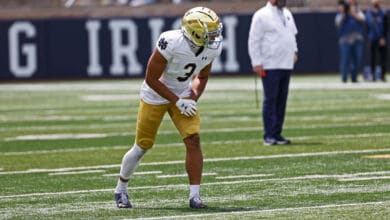
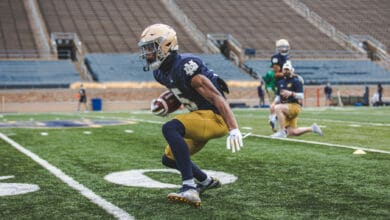
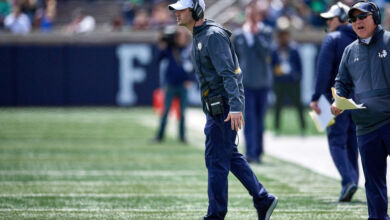
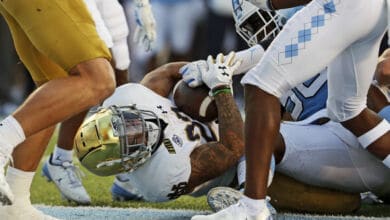
I am certain no one or very few will agree but here it is. Notre Dame wi not win a National Championship until they return to a two back offense and use it.
Please make sure Tommy and BK read this. I know they are watching film, but they have a tendency to over think things. BK also seems to get into his quarterbacks heads and they start not reacting to plays.
Spot on observations!
Greg,
This is one of the best analyses I’ve seen from the authors of this page. Well done.
Agree with you on all fronts!